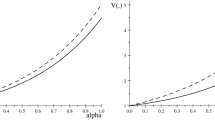Abstract
Professional options traders priced risky prospects as well as uncertain prospects whose outcomes depended on future values of various stocks. The prices of the risky prospects coincided with their expected value, but the prices of the uncertain prospects violated expected utility theory. An event had greater impact on prices when it turned an impossibility into a possibility or a possibility into a certainty than when it merely made a possibility more or less likely, as predicted by prospect theory. This phenomenon is attributed to the subadditivity of judged probabilities.
Similar content being viewed by others
References
Becker, Gordon M., Morris H., DeGroot, and Jacob, Marschak. (1964). “Measuring Utility by a Single-Response Sequential Method,” Behavioral Science 9, 226–232.
Camerer, Colin. (1995). “Individual Decision Making.” In John, Kagel and Alvin, Roth (eds.), Handbook of Experimental Economics. Chapter 8, p. 587–703. Princeton: Princeton University Press.
Gilboa, Itzhak (1987). “Expected Utility With Purely Subjective Non-Additive Probabilities,” Journal of Mathematical Economics 16, 65–88.
Kahneman, Daniel, and Amos, Tversky (1979). “Prospect Theory: An Analysis of Decision Under Risk,” Econometrica 47, 263–291.
Luce, R. Duncan, and Peter C., Fishburn (1991). “Rank and Sign-Dependent Linear Utility Models for Finite First-Order Gambles,” Journal of Risk and Uncertainty 4, 29–59.
Quiggin, John (1982). “A Theory of Anticipated Utility,” Journal of Economic Behavior and Organization 3, 323–343.
Schmeidler, David (1989), “Subjective Probability and Expected Utility Without Additivity,” Econometrica 57, 571–587.
Tversky, Amos, and Craig R., Fox. (1995). “Weighing Risk and Uncertainty,” Psychological Review 102, 269–283.
Tversky, Amos, and Daniel, Kahneman. (1992). “Advances in Prospect Theory: Cumulative Representation of Uncertainty,” Journal of Risk and Uncertainty 5, 297–323.
Tversky, Amos, and Derek J., Koehler. (1994). “Support Theory: A Nonextensional Representation of Subjective Probability,” Psychological Review 101, 547–567.
Tversky, Amos, and Peter, Wakker (1995). “Risk Attitudes and Decision Weights.” Econometrica 63, 1255–1280.
Wakker, Peter. (1989). “Continuous Subjective Expected Utility With Non-Additive Probabilities,” Journal of Mathematical Economics 18, 1–27.
Wakker, Peter, and Amos, Tversky. (1993). “An Axiomatization of Cumulative Prospect Theory,” Journal of Risk and Uncertainty, 7, 147–176.
Wu, George, and Richard Gonzalez. (1995). “Curvature of the Probability Weighting Function,” Management Science.
Yaari, Menachem E. (1987). “The Dual Theory of Choice Under Risk,” Econometrica 55, 95–115.
Author information
Authors and Affiliations
Rights and permissions
About this article
Cite this article
Fox, C.R., Rogers, B.A. & Tversky, A. Options traders exhibit subadditive decision weights. J Risk Uncertainty 13, 5–17 (1996). https://doi.org/10.1007/BF00055335
Issue Date:
DOI: https://doi.org/10.1007/BF00055335




